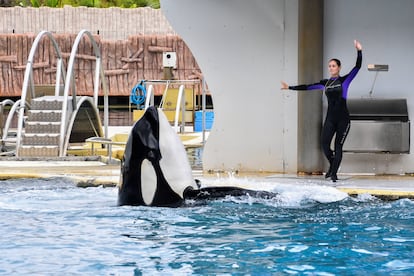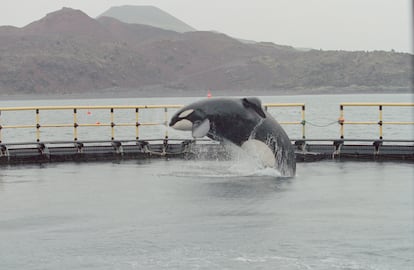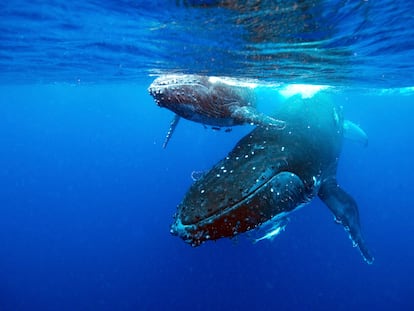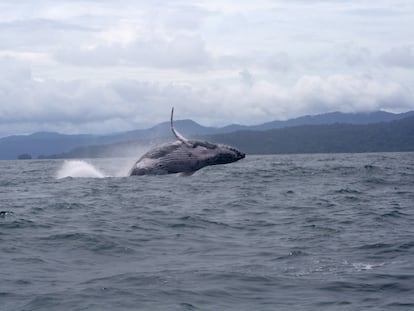Free Wikie: What happens to captive killer whales when their parks close?
The adult female, seeking a new home with her calf after the closure of Marineland in France, faces the grim reality of cetaceans used in human entertainment: there is only one marine sanctuary and total release into the wild is not considered for specimens bred in captivity

It all began with Moby Doll, one of the first orcas to be displayed in an aquarium after being captured in 1964 off Saturna Island, Canada. Though he survived only 87 days, Moby Doll proved that it was possible to keep this impressive, highly sociable, and intelligent cetacean in captivity, sparking what became known as orca mania. Now, more than 60 years later, 57 orcas live in 14 water parks around the world, where they perform in shows for human entertainment. Of these, 22 were captured from the wild, 33 were born in captivity, and two were rescued from strandings and have no chance of returning to their natural habitat, according to the latest data from Cetabase. It’s also estimated that more than 3,000 bottlenose dolphins and around 300 belugas are in similar conditions.
Alongside the moral dilemma that has long surrounded the ethics of this practice, there is also the challenging situation faced by these animals when a facility closes, as was the case recently with the two orcas at Marineland in Antibes, located on the French Riviera. Wikie, a 23-year-old female born in captivity, and her 10-year-old son Keijo, along with 12 bottlenose dolphins, are still awaiting their fate.
“It is an unresolved problem in a world where cetaceans continue to be captured for international trade in Cuba, Japan and Russia and may exist in countries in Africa and the South Pacific, such as China and Indonesia, for national use,” says the Foundation for Advice and Action in Defense of Animals (Faada), which has launched the SOS Dolphins campaign. This situation is further complicated by the fact that captive breeding is still permitted, the organization adds.
For the cetaceans held in captivity around the world, there are three possible outcomes: transfer to other aquariums, retirement to enclosed sea sanctuaries where they would receive care, or total release back into the wild.
Retirement in a sanctuary

The possibility of relocating captive cetaceans to marine sanctuaries — enclosed areas in bays where they would be looked after for the rest of their lives, without being forced to participate in shows — has gained momentum in recent years. Currently, there is only one such sanctuary in operation: it is located in Iceland, managed by Sea Life Trust, and houses two belugas — Little Grey and Little White. These small whales, native to the Arctic and subarctic regions, live in groups. In 2019, they embarked on a journey of nearly 6,300 miles from an aquarium in Shanghai to their new home. Initially, they were placed in pools within the bay to help them acclimatize, gain weight, and adjust to the colder temperatures. They are still adapting: in January 2025, a rain simulator was introduced in their pools to allow them to experience this new sensation. The sanctuary has the capacity to house eight belugas.
Another advanced project is the Whale Sanctuary Project in Nova Scotia, Canada, although it has yet to welcome any cetaceans. In April 2024, they offered their facilities to house the orcas from Marineland. However, France rejected the offer in January, citing issues with the owners’ deadlines and concerns about the water temperature. In response, the Whale Sanctuary Project sent another letter expressing regret that none of the experts who evaluated their request had reached out to them. They also criticized not being informed of the deadlines set by Marineland, which has led to delays and risks of the orcas being sent to Loro Parque in Tenerife, Spain. The sanctuary has requested a meeting with all parties involved to find the best solution.
Release into the wild

Releasing the killer whales from Marineland into the wild was ruled out by experts consulted by the French government. According to the experts, it is an option that is “doomed to failure for animals that have mostly been born and raised in captivity, as they are unable to hunt and feed themselves, have never eaten live fish, and seek human contact, which could also pose safety risks.”
However, there are instances when reintroduction works, depending on the individual animal. “It’s essential to study each case, to think about the origin of the animals and their history,” explains Andrea Torres, head of Faada’s wildlife division. She gives the example of Misha and Tom, two male bottlenose dolphins who lived in a chlorinated pool at the Hisaronu tourist center in Turkey, where tourists swam with them. The Born Free organization launched a campaign to rescue them, and since they were captured at the age of 12, they were deemed suitable for release back into the wild. After a thorough rehabilitation program, they were successfully released in 2012.
The case of Keiko, the famous male orca who starred in the film Free Willy, released in 1993, illustrates the challenges when dealing with an animal trapped as a calf. Keiko was captured in Iceland in 1979 when he was about two years old. He spent six years in tanks in Iceland and Canada with other orcas before being sold to an amusement park in Mexico, where he lived for 11 years, from 1985 to 1996, in a small pool without any contact with other orcas.
His release came about due to the social pressure following the success of the film. In 1998, he was moved to a closed bay in Iceland, from which he would venture out and spend days near groups of orcas. He swam between Iceland and Norway, but the only “pods” he ever was close to were the boats of people who harassed him. Initially, Keiko interacted with them, but then he entered a period of inactivity. Keiko died in December 2003 from what appeared to be pneumonia at the age of 26. A scientific study of his release, published in 2009, concluded that the release attempt was “not successful, since though physically unrestricted and free to leave, he kept returning to his caretakers for food and company.” However, for Torres of Faada, despite never joining a pod, “when he died, Keiko was a free orca.”
The outcome is very different for cetaceans that have spent very little time under human care, such as Springer, a young orphaned orca found in January 2002 north of Vancouver Island, Canada. She was successfully released into the wild with her family group just seven months later.
Transfer to another park
The simplest option, and the one Marineland had in mind, is to transfer the animals to a similar facility. However, this is the most controversial choice, as many people and conservation organizations argue that it would not only continue the captivity but also perpetuate their involvement in shows and captive breeding programs. For example, in January, the Madrid Zoo moved its dolphins to more modern facilities on the tropical island of Hainan, China. But the French government has refused to allow the orcas to be transferred to the Kobe Suma aquarium in Japan, chosen by Marineland’s owners, because it does not meet European quality standards. The latest proposal on the table is to transfer them to the Loro Parque park in Tenerife.
Javier Almunia, director of the Loro Parque Foundation, cautions that “it must be understood that most of the orcas currently in aquariums are grandchildren or great-grandchildren of animals captured last century, so they have never known any other way of life.”
Loro Parque is home to three orcas: two males, third and fourth generation in captivity, who arrived from SeaWorld in the United States, and a female, Morgan, who was rescued in the Netherlands in 2010. Morgan, who is deaf, communicates with her trainers through lights. Over the past 19 years, three calves have been born at Loro Parque, though only one has survived.
Regarding sanctuaries, Almunia acknowledges that while they “seem attractive at first glance,” they are complicated to manage because “these animals have an aversion to change.” For example, the two belugas at the Icelandic sanctuary “have only spent 72 days in the sanctuary bay in the five years they have been there,” says Almunia.
Sign up for our weekly newsletter to get more English-language news coverage from EL PAÍS USA Edition
Tu suscripción se está usando en otro dispositivo
¿Quieres añadir otro usuario a tu suscripción?
Si continúas leyendo en este dispositivo, no se podrá leer en el otro.
FlechaTu suscripción se está usando en otro dispositivo y solo puedes acceder a EL PAÍS desde un dispositivo a la vez.
Si quieres compartir tu cuenta, cambia tu suscripción a la modalidad Premium, así podrás añadir otro usuario. Cada uno accederá con su propia cuenta de email, lo que os permitirá personalizar vuestra experiencia en EL PAÍS.
¿Tienes una suscripción de empresa? Accede aquí para contratar más cuentas.
En el caso de no saber quién está usando tu cuenta, te recomendamos cambiar tu contraseña aquí.
Si decides continuar compartiendo tu cuenta, este mensaje se mostrará en tu dispositivo y en el de la otra persona que está usando tu cuenta de forma indefinida, afectando a tu experiencia de lectura. Puedes consultar aquí los términos y condiciones de la suscripción digital.
More information
Archived In
Últimas noticias
$3,000 and a plane ticket: The United States increases incentives for migrants to self-deport before the end of the year
Charles Dubouloz, mountaineering star, retires at 36 with a farewell tour inspired by Walter Bonatti
From the White House to diplomatic gifts: Lego wins over adult fans, brick by brick
Kate Winslet makes her directorial debut: ‘There aren’t more female directors because we’re busy raising children’
Most viewed
- Families demand repatriation of bodies of Colombians who died in Ukraine: ‘This war is a slaughterhouse for foreigners’
- The low-cost creative revolution: How technology is making art accessible to everyone
- Liset Menéndez de la Prida, neuroscientist: ‘It’s not normal to constantly seek pleasure; it’s important to be bored, to be calm’
- Christian Louboutin: ‘Young people don’t want to be like their parents. And if their parents wear sneakers, they’re going to look for something else’
- Christmas loses its festive spirit: ICE fears cast shadow over religious celebrations











































